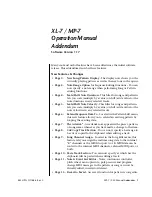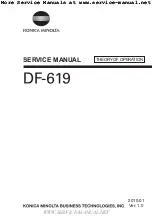
1.800.362.3860
1.888.362.2576 Fax
www.good-lite.com
1.800.362.3860
1.888.362.2576 Fax
www.good-lite.com
VIP Crowded Acuity Test
VIP Crowded Acuity Test
3
How You Do the Test:
1. If the child is wearing glasses, do not remove them.
2. Position the child 5 feet from the card.
3. Complete
Pretesting
to find out whether the child is able to
perform the test:
a. Place the Lea lap card on the child’s lap with the symbols
right side up as the child is looking at them. The lap card
should be flat on the child’s lap so the examiner can see the
symbol the child is pointing to.
b. Hold up one of the pretesting cards about 1.5 to 3 feet
from the child. Ask the child to name or point to (“touch”)
the symbol on the lap card that is the same. Continue this
procedure until all 4 symbols have been correctly named or
matched. Each symbol can be presented up to 2 times. If
the child cannot identify all of the symbols by matching or
naming, check the “
Unable
” box on the recording form and
stop
testing. Continue testing if the child is able to match
or name all of the symbols.
c. Note: Other names for the symbols are acceptable as
long as the child uses them consistently. For example, the
child may call the apple a heart or the circle an “O” or the
rectangle a window. However, if the child ever starts using
a new name or there is ever any question about which
symbol the child is referring to, the child should be asked to
point to the symbol on the lap card.
4. Complete
Testing at 5 Feet: Right eye disk
a.
Occlude the left eye:
i. Place the occluder glasses on the child so that the left
eye is covered. If you have difficulty getting the child to
wear the occluder glasses, try letting the child admire
himself/herself with the glasses on using a hand-held
mirror.
ii. If the child is unable or refuses to wear the occluder
glasses, attempt to cover the left eye with micropore
tape (make sure to protect the eye from the adhesive on
the tape) or an eye patch.
iii. If the child refuses to wear the occluder glasses,
micropore tape, or eye patch, have a helper cover the
child’s eye with the palm of his/her hand. The examiner
must monitor the child carefully to make sure he/she is
not peeking and that the palm is not pressing against
the child’s eye. Covering the eye with fingers is not
allowed because peeking is too easy with only
fingers
in front of the eye. If the child refuses to allow a helper
to cover the eye, the child can cover his/her own eye
with the palm of his/her hand.
b. Check the position of the child for testing. The child’s eyes
will need to be at the same height as the cards.
c. Begin
Age-specific visual acuity testing
i. Turn the wheel until the first symbol (numbered
3R1
for 3-year-olds or
4R1
for 4- and 5-year-olds) is
in the window. Have the child name or match the
corresponding Lea symbol. After the child gives his/her
response, rotate the wheel clockwise to the next
symbol (numbered
3R2
for 3-year-olds or
4R2
for 4- and
5-year-olds).
ii. Whenever the child gets a symbol wrong, place an ‘X’ on
the corresponding symbol on the recording form.
iii. If the child misses 1 or none of the first 4 symbols (R1,
R2, R3, and R4) continue testing successive symbols
(R5-R8) until a child gets 2 symbols wrong on a line of
symbols on the recording form or completes testing on
all symbols.
1. If the child completes all the symbols without getting
any X’s, check the box on the recording form stating
that all symbols were identified correctly.
iv. If the child misses 2 or more of the first 4 symbols,
complete the
baseline flip book testing
as follows:
1. Remove the disk card from the slot on the lamp
stand.
2. Place the baseline flip book on the front ledge of the
lamp stand.
3. Have the child name or match each symbol for the
right eye. If the child incorrectly identifies a symbol,
put an X on the corresponding symbol on the
recording form.
4. If the child gets 2 or more wrong (2 or more X’s on
the line on the recording form),
STOP
and test the left
eye (See Step 5 below).
5. If the child correctly identifies all the symbols or
only gets 1 of the symbols on the baseline flip book
wrong (1 X on the line on the recording form), put
the disk card for the child’s age back into the slot
on the lamp (right eye disk side towards the child).
Turn the wheel until the first symbol (numbered
3R1
for 3-year-olds or
4R1
for 4- and 5-year-olds) is
in the window. Have the child name or match the
corresponding Lea symbol. Continue testing the right
eye with successive symbols until the child gets 2 or
more wrong on a line (2 or more X’s on the line on the
recording form).
5.
Testing at 5 Feet: Left eye
a. Occlude the right eye and flip the visual acuity testing card
(disk) over so that the left eye side of the card (disk) is
facing the child.
b. Begin age-specific acuity testing for the left eye (as in step
4c, above) beginning with the first symbol for the left eye
(numbered 3L1 for 3-year-olds or 4L1 for 4- and 5-year-
olds).
6. Wipe the ear pieces and nose area of the occluder glasses
with a tissue after each child is tested.
7. Clean the lap card with an antibacterial wipe as needed.
8. When you are finished testing, the testing materials can be stored
in the storage compartment on the back of the lamp stand.
What You Tell the Child:
1. Encourage the child by saying “Good job!” even if the child
names or matches the symbols incorrectly.
2. Urge the child to keep naming or matching the symbols even if
the child must guess.
3. Remind the child to stay in the same position and look straight
ahead at the cards.
Remember!:
1. Keep the child’s attention focused on the task.
2. Maintain the appropriate distance during the test.
3. Make sure the child does not peek.
4. Continue to the next line only if the child names or matches at
least three of the four symbols on a line.
Interpretation and Recording of Results:
1. Check the “PASS” box at the bottom of the recording sheet if
a child correctly names or matches at least three of four of the
smallest age-specific LEA Symbols (symbols 5-8). (For 3-year-
olds, the smallest symbols are equivalent to 20/50, and for
4- and 5-year-olds, they are equivalent to 20/40).
2. Check the “REFER” box at the bottom of the recording sheet
if a child is:
a. Unable to match the LEA Symbols at 3 feet (pretesting step)
b. Uncooperative for testing
c. Refuses to wear the glasses (or occlusion by the other
means discussed)
d. Unable to match at least 3 of 4 symbols on any line with
either eye
• Baseline Card (if tested)
• LEA Symbols 1 through 4
• LEA Symbols 5 through 8 (smallest age specific line)
Passing Criteria
Child's Age
Passing Criterion*
3-year-olds
5/12.5 Line (20/50)
4-year-olds
5/10 Line (20/40)
5-year-olds
5/10 Line (20/40)
* Child must correctly name or match at least three of four
symbols of this size (which is the smallest line of age-specific
Lea Symbols (symbols 5-8))
4L 4
4L 3
4L 2
4L 1
4L 8
4L 7
4L 6
4L 5
4Y
O LEFT
#300502
developed by Lea Hyvärinen, MD
Phone: 847-841-1145 Fax: 847-841-1149
Phone: 800-362-3860 Fax: 888-362-2576
www.good-lite.com
(00%-*5&
The Quality Always Shines Through
4- and 5-Year-Olds
Left Eye
Produced exclusively by:
As used in the Vision In Preschoolers (VIP) Study (sponsored
by the National Eye Institute of the National Institutes of Health
of the Department of Health and Human Services)
Part #300504
For Testing at
1.5 Meters (5 Feet)
LEA Symbol
Symbol Number
























